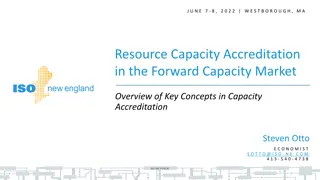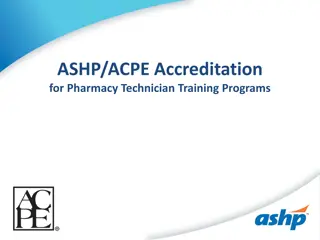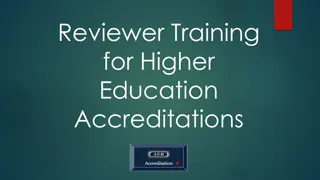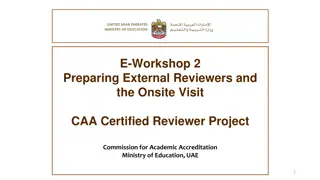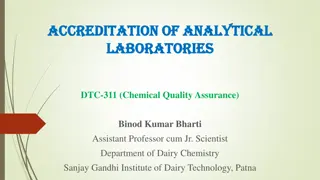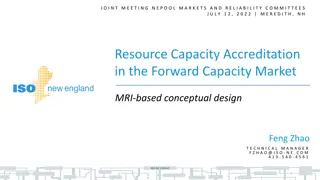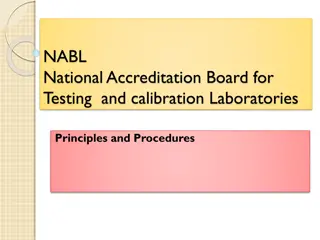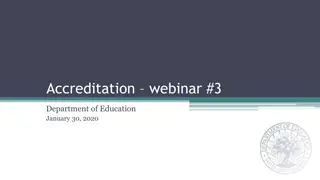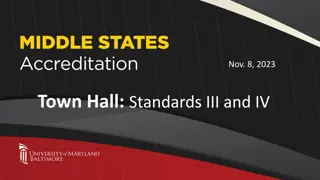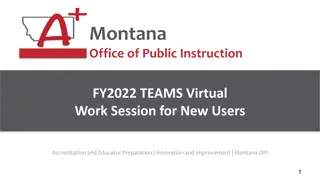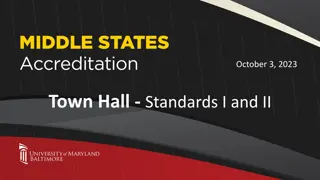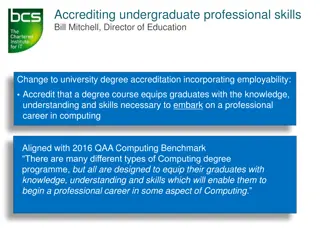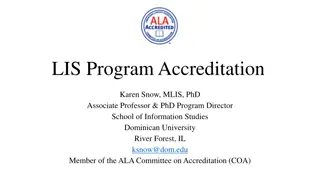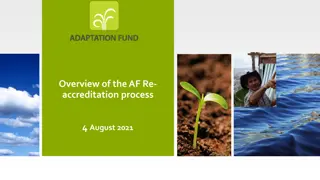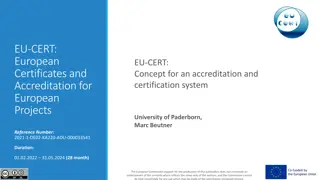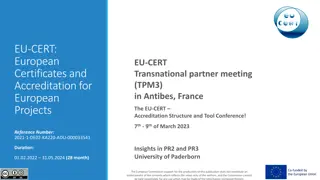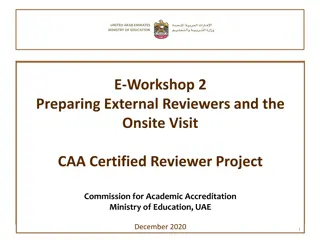Insight into K-12 Public Education Accreditation
This content provides detailed information on the accreditation process and benchmarks for K-12 public schools, including ratings awarded, standards of compliance, and criteria for fully accredited status. It also highlights the challenges faced by schools not fully accredited and the various accreditation ratings.
Download Presentation

Please find below an Image/Link to download the presentation.
The content on the website is provided AS IS for your information and personal use only. It may not be sold, licensed, or shared on other websites without obtaining consent from the author.If you encounter any issues during the download, it is possible that the publisher has removed the file from their server.
You are allowed to download the files provided on this website for personal or commercial use, subject to the condition that they are used lawfully. All files are the property of their respective owners.
The content on the website is provided AS IS for your information and personal use only. It may not be sold, licensed, or shared on other websites without obtaining consent from the author.
E N D
Presentation Transcript
House Ways & Means Committee / HHS Subcommittee FY 2021-22 Budget Request Thomas Clark Phillip Acting Director & Chief Financial Officer Feb. 2, 2021
Coronavirus Disease 2019 (COVID-19) Update Reserves, temporary enhanced Federal Medical Assistance Percentage (FMAP) and agency policy changes have helped mitigate the uncertainty of medical costs related to COVID-19 and the public health emergency Healthcare delivery flexibility (including expansion of existing telehealth benefit) Increase in enrollment Creation of new limited benefit program to cover cost of COVID-19 tests and vaccination administration No current plans to reduce provider reimbursement rates No current plans to drop optional services 2
FY 2019-20 Year-End & FY 2020-21 Year-to-Date 3
FY 2019-20 Year-End FY 2020 Total Funds Incl. Federal FY 2020 General/Other Funds Medicaid Assistance 1,774,598,379 $ $ 6,470,257,347 State Agencies $ 219,478,971 $ 837,525,033 Personnel & Benefits $ 31,251,645 $ 81,416,222 Medical Contracts & Operating $ 190,510,671 $ 424,168,124 Total Expenditures 2,215,839,666 $ $ 7,813,366,726 Revenues Received 2,374,515,491 $ $ 7,875,907,552 Percent Expended 93% 99% Agency ended FY 2020 under budget, cash surplus was 7% of general/other funds revenue and 1% over total funds revenue Much of the gap is associated with the following events: Extension of the public health emergency (PHE) and enhanced FMAP rate 4
FY 2020-21 2nd Quarter FY 2021 Continuing Resolution Budgeted % of Total Appropriation Expended % of Total Appropriation Through Q2 Appropriation Through Q2 Expenditures Medicaid Assistance 6,392,053,519 $ 3,140,753,493 $ 49.1% 3,277,041,932 $ 51.3% State Agencies & Other Entities 823,664,578 $ 394,078,077 $ 47.8% 373,449,436 $ 45.3% Personnel & Benefits $ 86,409,229 $ 43,204,615 50.0% 39,670,912 $ 45.9% Medical Contracts & Operating 489,604,044 $ 166,465,375 $ 34.0% 135,513,633 $ 27.7% Total 7,791,731,370 $ 3,744,501,560 $ 48.1% 3,825,675,913 $ 49.1% Agency spent approximately 49% of its annual budget during the first six months of the fiscal year Medical Contracts & Operating expenditures are traditionally lower in first half of fiscal year Large events such as supplemental teaching physician (STP) payments and graduate medical education (GME) payments will occur in second half of fiscal year 5
FY 2021-22 Budget Request Guiding principles for the request: Preserves the same general principles as last year Keeps reserves above 3% through the planning horizon Funds annualizations Updates financial baselines to reflect agency experience Limited proposals for targeted rate and program changes 7
FY 2021-22 Budget Request (cont.) General Funds Total Funds Recurring Requests Maintenance of Effort Annualization (MOE) Initiatives Community Long Term Care (CLTC) Census Growth Disproportionate Share Hospital (DSH) Allotment Increase State-funded contracts for non-covered populations SCDDSN Appropriation Transfer FY 2021-22 Recurring Changes 94,239,009 36,973,963 22,672,755 8,831,395 35,800,000 (1,808,437) 196,708,684 $ $ $ $ $ $ $ 278,032,066 $ 122,035,253 $ 76,545,093 $ 28,799,669 $ 1,000,000 $ (1,808,437) $ 504,603,644 $ Non-Recurring Request Non-Recurring: MMIS $ 16,678,434 117,048,236 $ 77% of general fund recurring request is to maintain current level of services FMAP annualizations requested in the entirety Full Children s Health Insurance Program (CHIP) FMAP reduction was effective October 2020 Governor s Executive Budget did not include funding for the following decision packages: $84 million general funds for MOE annualization Recurring general/federal/earmarked funds for initiatives, CLTC, DSH, or state-funded contracts for non-covered populations Non-recurring general/federal funds for Medicaid Management Information System project decision package 8
FY 2021-22 Budget Request (cont.) Most funding is for annualizations, but these would be new items: Initiatives - Provider reimbursement rate increase year 3 ($37 million general funds) Impacted groups include: Institutional providers, including hospitals and inpatient psychiatric units o Skilled nursing facilities for two years of rate re-baselining (FY21 & FY22) o Dental services o CLTC funding ($22.7 million general funds) CLTC waivers have realized a 50% growth in census/utilization over the last five years Requesting $22.7 million in general funds to continue to provide current services to CLTC waiver-eligible beneficiaries DSH allotment increase ($8.8 million general funds) Represents the aggregate limit on the federal share amount of the state's DSH payments to DSH hospitals in the state set by the Centers for Medicare and Medicaid Services (CMS) 9
FY 2021-22 Budget Request (cont.) Most funding is for annualizations, but these would be new items: State-funded contracts for non-covered populations ($35.8 million general funds) This request annualizes funding for optional state-funded programs and services for non-covered populations. A myriad of non-profits, hospitals, clinics, and state agencies provide and administer limited services to populations not covered by Medicaid or CHIP. These contracts are traditionally funded with agency reserves. South Carolina Department of Disabilities and Special Needs (SCDDSN) appropriation transfer ($1.8 million general funds) SCDHHS will transfer appropriations to SCDDSN in accordance with interagency contracts, executed pursuant to three 1915 (c) home and community-based service (HCBS) waivers, the recurring state match associated with non-waiver services provided by SCDDSN. 10
FY 2021-22 Proviso Changes Agency requested changes to six provisos: 33.20 Medicaid Accountability and Quality Improvement Initiative Delete (not included in Executive Budget) SCDHHS is requesting to delete proviso if decision package six is not funded. If decision package six is not funded, the Department would curtail, eliminate, or redesign the relevant contracts and agreements to reduce the state fund only spend or conform them to the requirements of Medicaid or CHIP, rendering this proviso moot. 33.23 DHHS: BabyNet Compliance Amend The requested change is a technical amendment to update the reporting date. 33.EMD Meals in Emergency Operations Add (not included in Executive Budget) SCDHHS is requesting to add a proviso that would allow the Department to purchase meals for employees who are engaged in emergency response and are unable to leave their post, or when travel may be restricted due to the emergency response. The Department expects this to most often be the result of shelter duty during hurricane evacuations but would request the flexibility for any emergency response scenario. 117.118 BabyNet Delete (Executive Budget amends the reporting date) This proviso relates to a Legislative Audit Council recommendation from 2011, when the Individuals with Disabilities Education Act (IDEA) Part C program lead agency responsibilities were with First Steps to School Readiness. Since the implementation of Executive Order 201620 and subsequent actions by the General Assembly through the appropriations act and actions by SCDHHS administratively, this proviso has become moot. 117.120 South Carolina Telemedicine Network Amend Delete reference to report as it has been completed. 117.126 Opioid Abuse Prevention and Treatment Plan Amend SCDHHS recommends striking a one-year provision directing funding to a county with a disproportionately high number and/or incidence of opioid related overdoses and deaths. SCDHHS also proposes striking the required report that has been prepared and provided. 11
FY 2021-22 Proviso Changes (cont.) Three additional proviso changes included in the Governor s Executive Budget: 33.24 Personal Emergency Response System Delete The proviso requires the department to develop one or more Requests for Proposals, to provide for Personal Emergency Response Systems (PERS) to be issued to Medicaid recipients pursuant to the department s Medicaid Home and Community-based waiver. The proviso also gives guidance regarding required system capability and service. The Executive Budget recommends the deletion of this proviso in accordance with the governor s vetoes in the FY 2019-20 Appropriations Bill. 33.26 Medical Contract Grants New The Executive Budget recommends adding this proviso creating a grants committee at the Department of Health and Human Services, setting criteria for grant awards, and requiring external evaluation of grantees. 33.27 Defunding Planned Parenthood - New This proviso prohibits the Department of Health and Human Services from accepting federal funding for family planning. The agency is also given guidance regarding the prohibition of appropriating state funds for family planning that directly or indirectly subsidizes abortion services, procedures, or administrative functions. An otherwise qualified organization may not be disqualified from receipt of these funds because of its affiliation with an organization that provides abortion services, provided that the affiliated organization that provides abortion services is independent of the qualified organization. The Executive Budget recommends the establishment of this proviso. 12
Pricing Project Phase I - Effective July 1, 2019 Professional provider types Projected impact = $26.2 million total funds Phase II Some effective Jan. 1, 2020; others July 1, 2020 January 2020 Private duty nursing received a 5% rate increase July 2020 vision, ambulatory surgical centers, anesthesia, attendant care, adult day health care transportation, pediatric day care, private duty nursing Projected impact = $49.3 million total funds Phase III TBD Impacted groups include o Institutional providers, including hospitals and inpatient psychiatric units o Skilled nursing facilities for two years of rate re-baselining (FY21 & FY22) o Dental services Projected Impact = $122 million total funds 13
Full-Benefit Membership 1,150,000 1,125,000 1,100,000 1,075,000 1,050,000 1,025,000 1,000,000 Oct-17 Oct-18 Oct-19 Oct-20 Apr-17 Jun-17 Aug-17 Apr-18 Jun-18 Aug-18 Apr-19 Jun-19 Aug-19 Apr-20 Jun-20 Aug-20 Dec-16 Feb-17 Dec-17 Feb-18 Dec-18 Feb-19 Dec-19 Feb-20 Dec-20 During the public health emergency, full-benefit membership has increased to around 1.15 million. 15
Full-Benefit Membership (cont.) 1,250,000 1,200,000 1,150,000 1,100,000 1,050,000 1,000,000 950,000 900,000 850,000 800,000 July August September October November December January February March April May June FY 2020 Actuals FY 2021 Actuals FY 2021 Re-Projection Estimated actuals based on 6-month completion factor 16
Asymmetric Resource Utilization 7.0% 16.8% 12.2% 18.9% 33.7% 16.6% 61.9% 33.0% Enrollment Expenditures 17
Budgeting for Aging on the Margins Disabled Dual Cat Child Parent Elderly Per Member Per Month $200 $400 $1,200 $900 Members -1,000 0 1,000 1,000 Annual Cost $(2.4M) $0 $14.4M $10.8M Net $ 22.8M State $ 6.8M 18
Eligibility and Enrollment Continuing Efforts Operations Opened a statewide processing center (PC) in Florence in July 2020 18,781 customers served in local eligibility offices prior to emergency period with average wait time of 24 minutes 34,390 customers served in local eligibility offices since re-opening amid new COVID-19 protocols with average transaction time of 5 minutes Workload and Productivity since January 2020 Reduced pending total applications by 14% Reduced pending total reviews by 19% Reviewed 69,472 eligibility determinations with 93% worker accuracy confirmed Hiring Additional PC staff hired include 1 PMII, 1 PMIs, 3 supervisors and 63 eligibility workers Flexed eligibility staffing by 29% to match change in incoming applications and reviews Training Offered 420 classes (78 classroom and 345 webinars) with over 12,000 attendees Launched Curam Global Income Support (CGIS) Non-Modified Adjusted Gross Income (MAGI) pilot Nov 2020 with training scheduled for completion August 2021 19


